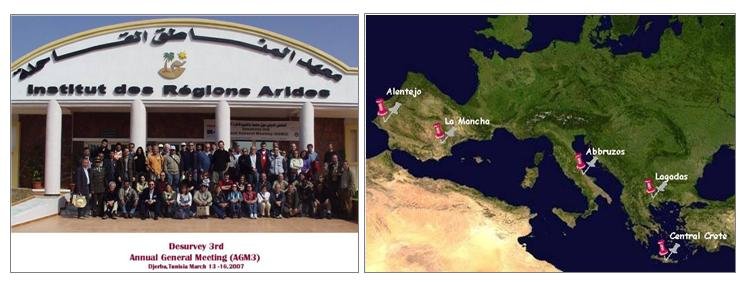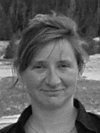Surveillance System for the Assessment and Monitoring of Desertification

DeSurvey
Desertification surveillance is required for making one-off and periodic assessments of desertification status, for forecasting possible trajectories (early warning), and for evaluating the performance of management programmes. However, assessment procedures have so far been largely empirical and focused on the symptoms of desertification (land degradation) rather than on the underlying human-environment interactions and processes.
The DeSurvey integrated project aims at delivering a low cost and flexible desertification surveillance system. For this, a compact set of integrated procedures of desertification assessment and forecasting, with application and tutorial examples at the EU and national scales will be developed. The performance of DeSurvey in other desertification threatened areas of UNCCD regional Annexes will be also tested against other expertise and available procedures. The DeSurvey consortium consists of 39 partners representing 10 EU Member States and 6 Third Country States that integrate key research organisations and industrial companies with a wide range of skills. The project is funded by the EU Framework Programme 6, Priority 1.1.6.3 "Global Change and ecosystems", and is being lead by Prof Puigdefabregas, CSIC/EEZA, Almeria, Spain. Five European sites (Greece, Spain, Italy, Portugal) have been selected by the Executive Committee to allow the development of modelling, scaling and validation activities. For more information, see the DeSurvey web site.
The objectives of Work Package 1.5.4 (Uni Valencia, GFZ, DLR, Uni Trier) are the development, evaluation and validation of advanced remote sensing approaches. The WP1.5.4 focuses on the (i) assessment of the combination of new sensors and new methods in the retrieval of enhanced biophysical and geochemical surface parameters (LAI and FVC, soil chemical properties) with better accuracy over areas affected by land degradation processes and (ii) the validation of these products. A detailed description of the derived maps are described in the deliverables, available to the DeSurvey community. The GFZ remote sensing section contribution focuses on the derivation of enhanced soil variables linked with land degradation. Different methodologies were developed for validation purposes, and multi-scale (up- and down-scaling) approaches.
For example, quantitative determination of citrate-dithionite extractable iron content have been achieved with good accuracy and repeatability. Based on the spectral properties of soils in the visible-near infrared range of the spectrum and a spectral correlation analysis method, soils maps in variable environments and with variable spatial resolutions were developed in GFZ. The methodology applies an automatic feature-based correlation technique using linear regression models to correlate chemical analysis of field samples with characteristic spectral features in the corresponding reflectance spectrum such as ratios, absorption depth or absorption area. Based on these models and on the correlation with soil chemical analyses, free iron oxyde and C-O absorption maps were developed. Soil chemical analyses were performed by the university of Almeria in the INCAMAR frame. The approach is limited to areas where soils are well exposed and suitable for a remote sensing analysis, and extractable iron content is within a reasonable range. For more information, see Richter et al., 2007.
Project Homepage:



